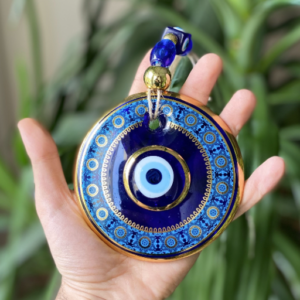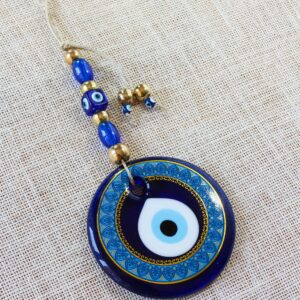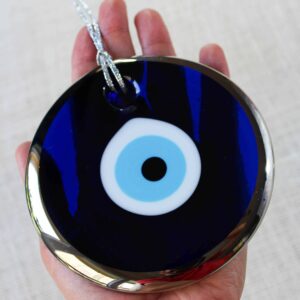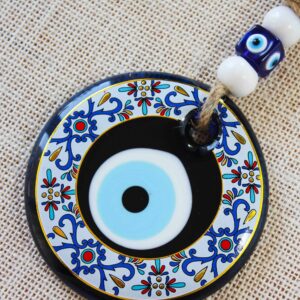Evil Eyes
Evil Eye – Nazar Boncuk
Nazar, Mal de ojo, Greek evil eye, Turkish evil eye, Mati, Ayin ha-ra
The evil eye is a belief that a person can cause harm or misfortune to others by simply looking at them with envy or jealousy. This belief is widely recognized across many cultures, including ancient Greek, Roman, Turks and Middle Eastern civilizations, as well as contemporary Jewish and Muslim cultures.
The evil eye is often represented by a blue bead with a black center that resembles an eye. This charm is commonly worn as jewelry, hung in homes, or placed on vehicles to provide protection against the negative effects of the evil eye.
In many cultures, the belief in the evil eye is associated with envy and jealousy, and it is believed that those who possess a strong gaze can cast the evil eye upon others, causing harm to their health, wealth, and well-being. To counteract the evil eye, people often use various methods, such as wearing amulets or talismans, reciting protective prayers and blessings, or performing rituals.
The evil eye is a powerful symbol in many cultures, representing the belief in the power of the gaze to cause harm or bring misfortune. Despite its ancient origins, the belief in the evil eye continues to be an important aspect of many cultures and continues to be used as a means of protection against negativity.

- $8.99Select options This product has multiple variants. The options may be chosen on the product page
- Price range: $11.99 through $13.99Select options This product has multiple variants. The options may be chosen on the product page
Evil Eye Meaning and History
The evil eye bead, also known as a nazar, is a charm that has been used for centuries to ward off evil and bring good luck. Its history can be traced back to ancient civilizations such as the Greeks, Romans, Turks and Persians, who believed in the power of the evil eye to cause harm.
The evil eye bead is typically a blue glass bead with a black center that resembles an eye. The color blue is believed to represent the sky and heavens, and the black center symbolizes the pupil, reflecting the malevolent gaze of the envious. The bead is often worn as jewelry, hung in homes, or placed on vehicles to provide protection.
In ancient Greece, the belief in the evil eye was widespread, and it was believed that the eye of envy could cause harm to crops, animals, and even people. To protect themselves, people would wear amulets or talismans in the shape of eyes to deflect the evil gaze. In addition to wearing amulets, people would also practice rituals to remove the curse of the evil eye, such as washing their face with saltwater or burning herbs.
In ancient Rome, the evil eye was believed to bring misfortune, illness, and death, and people would wear amulets to protect themselves. The Roman historian Pliny the Elder wrote about the power of the evil eye and the need to protect oneself from its harmful effects.
The belief in the evil eye also spread to the Middle East, where it was widely recognized among the Persians, Arabs, and Turks. In Muslim culture, the evil eye is referred to as “ayn al-hasad,” and it is believed that the envious gaze of others can bring harm to one’s health and well-being.
In modern times, the evil eye bead remains a popular charm and is used in many cultures as a symbol of protection and good luck. The bead can be found in many different shapes and sizes, and it is often given as a gift to new parents to protect their children, or to someone starting a new venture to bring them good luck.
The evil eye bead has a rich history that spans several thousand years and encompasses many cultures and civilizations. Despite its ancient origins, the charm remains popular today and is widely recognized as a symbol of protection and good luck.
How Important Is Evil Eye in the History of Turks and Greeks ?
The evil eye is considered to be an important aspect of the cultural and historical heritage of both Greeks and Turks.
In Greek history, the evil eye, known as “mati,” was a widely recognized and feared symbol of misfortune and bad luck. Greeks believed that the evil eye was the result of someone looking at them with envy or jealousy, and that this gaze could cause harm to their health, wealth, and overall well-being. To protect themselves against the evil eye, Greeks often wore amulets, such as the blue glass bead with a black center that represented an eye, and made sure to avoid drawing attention to themselves, as they believed that pride and arrogance could attract the evil eye.
In Turkish culture, the evil eye, known as “nazar,” is an important symbol of protection and good luck. Turks believe that the evil eye can bring harm to individuals, families, and entire communities, and that it is particularly dangerous for children and pregnant women. To protect against the evil eye, Turks often wear amulets and talismans, such as the blue bead with a black center, and use various rituals, such as burning herbs and submerging the amulets in saltwater, to purify them and remove the negative energy associated with the evil eye.
The evil eye holds an important place in both Greek and Turkish history and continues to be a significant aspect of these cultures today. Through the use of amulets, talismans, and rituals, both Greeks and Turks seek to protect themselves against the negative effects of the evil eye and ensure good luck and prosperity in their lives.
How Important Is Evil Eye in the History of Jewish ?
The evil eye has played an important role in Jewish history and continues to be a significant aspect of Jewish belief and culture. In Jewish tradition, the evil eye, known as “ayin hara” in Hebrew, is believed to be a powerful and negative force that can bring harm to individuals, families, and entire communities.
The belief in the evil eye is rooted in ancient Jewish texts and is mentioned in various Talmudic and Midrashic sources. In these texts, the evil eye is described as a gaze that can bring misfortune, ill health, and poverty to those who fall under its spell.
To protect against the evil eye, Jews have historically worn amulets and talismans, such as the hamsa hand, which is a symbol of protection against the evil eye and other negative forces. Additionally, Jewish homes and businesses often display the hamsa hand or other symbols of protection to ward off the evil eye.
In Jewish folklore, the evil eye is also associated with envy and jealousy, and it is believed that those who possess a strong gaze can cast the evil eye upon others. To counteract the negative effects of the evil eye, Jews often recite protective prayers and blessings, such as the Shema Yisrael and the Birkat Ha-Mazon.
The evil eye is an important aspect of Jewish history and continues to play a significant role in Jewish culture and belief. Jews have used various methods, such as amulets, talismans, and blessings, to protect themselves and their families against the negative effects of the evil eye.





















